Use this Leo Lionni author study to help you create a unit of study for your classroom.
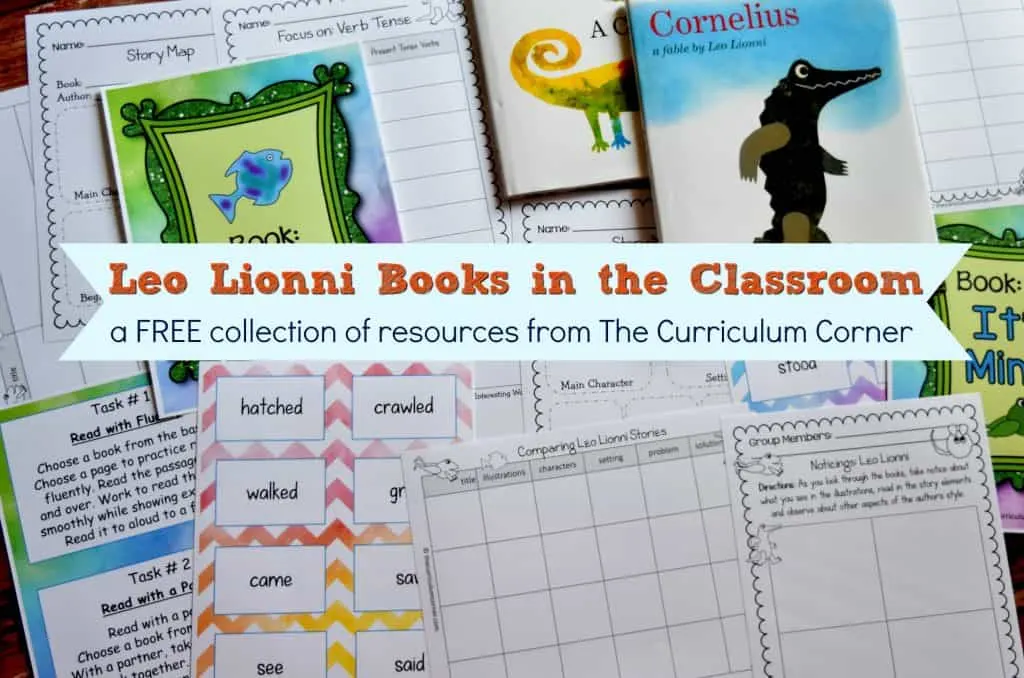
This is another free resource for teachers from The Curriculum Corner.
You can download this collection by clicking on the bold, orange link below in this post.
Getting started with your Leo Lionni author study
Noticings
Many times starting out with “noticings” about books is a good way to get students thinking about similarities in an author’s style. If you choose to begin with noticings, try to gather enough Leo Lionni books so that each group has at least two to look through.
We have provided a graphic organizer for groups to fill out. After giving them some time, gather them together to discuss their findings. You will find a blank noticings poster that you can use to record their ideas.
On our kindergarten site you will find a completed noticings chart in the Lionni Writing Unit we created.
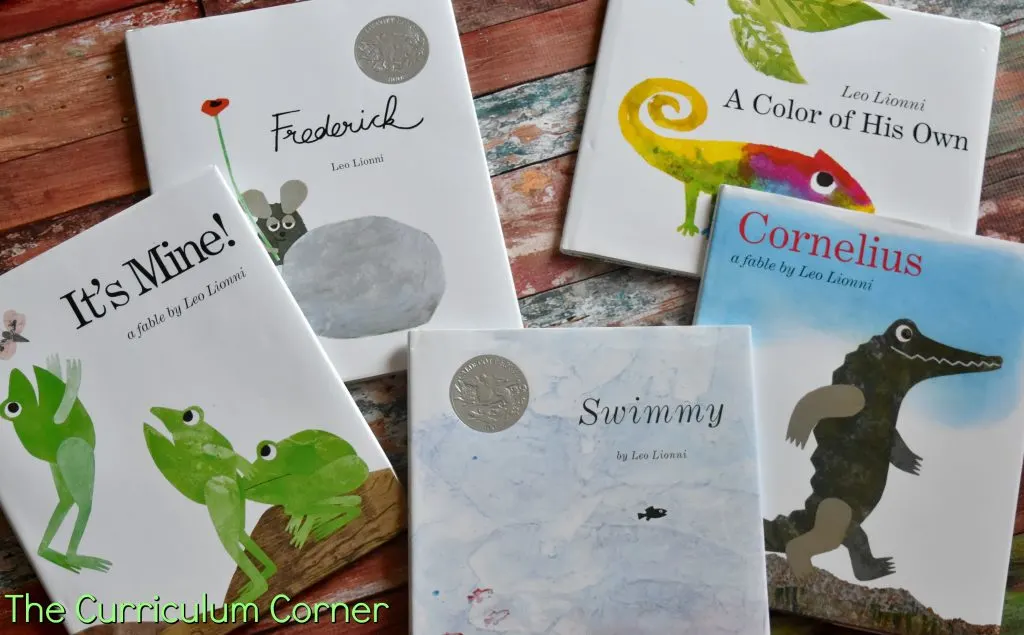
Task Cards & Graphic Organizer for any Leo Lionni Books
You can use these task cards and graphic organizers at literacy centers. Simply put a large collection of Lionni books in a basket for students to choose from. Then, print & laminate the task cards and copy the pages for students to choose from. (Some of the task cards have more than one organizer you can choose from for your students.)
You can also use the graphic organizers as mini-lessons focusing on learning more about Leo Lionni, his characters and style. (The last task might also be a good culminating activity to the study of Leo Lionni. It involves comparing several of the story elements in his books.)
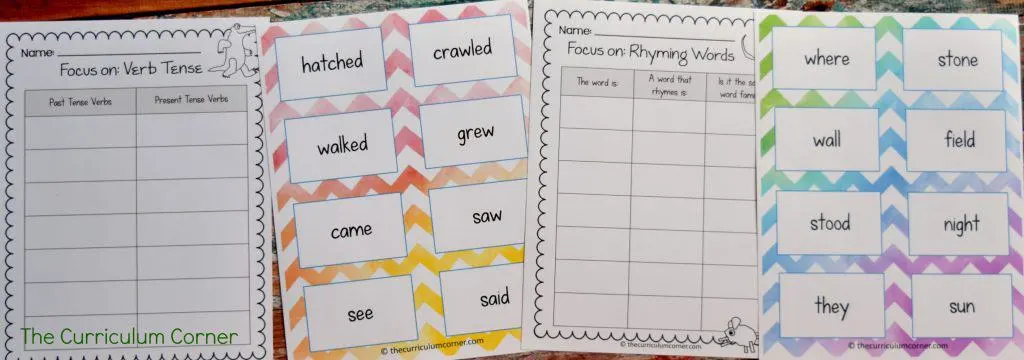
The following resources have been created to correspond with specific Leo Lionni books.
It’s Mine!
Vocabulary Words/Language Sort – This story is filled with wonderful words. We have provided several of these on individual cards that you can use for a few purposes.
- Choose the words you want and display them for students. Discuss their meanings before reading the story. Then follow the reading with a whole class or small group sort of the types of words. We have provided four different organizers for categorization that describe the types of words in different ways. Choose the one that suits your objective and the needs of your learners.
- Focus on Adjectives – Have students use the adjective organizer to illustrate the various adjectives from the story. You can highlight them as you read the story aloud or pick out the adjectives from the word cards in the activity above.
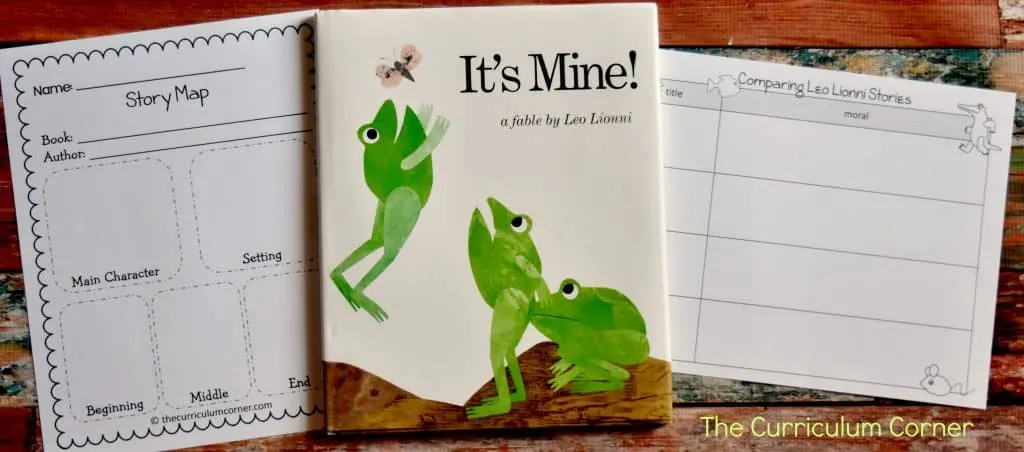
Frederick
Frederick Rhymes! Can You? – The field mice at first think Frederick is simply lazy. They later come to understand that Frederick is truly a poet and that his words can help them through their long winter. After reading the story, start this lesson by looking at the rhymes from Frederick’s poem at the end. Distinguish between the rhymes that share the same word family and those that don’t. Use our t-chart organizer with your students to look at and discuss those pairs of words. Next use the word cards (words from the story) to brainstorm other rhyming words. Students can think words in the same word family and those that are not.
Feelings About Frederick – Students can use their inference skills to figure out how the mice’s feelings about Frederick change during the story. Use this graphic organizer to get your students thinking about how their background knowledge paired with the words and events in the story can help them infer the feelings.
Swimmy
Creatures of the Sea – This story is also filled with descriptive writing. It lends itself to wonderful visualization possibilities. For this activity, you will need to find video clips that you feel show the following things the best:
- medusa made of rainbow jelly
- lobster who walked about like a water moving machine
- strange fish pulled by an invisible thread
- a forest of seaweeds growing from sugar candy rocks
- an eel whose tail was almost too far away to remember
- see anemones who looked like pink palm trees swaying in the wind.
Before reading the story, you may have to have a short discussion about some of the words – medusa, lobster, eel, anemones – so that students have some idea of what they are. Then, separate your class into six groups and give each group a card to read aloud and copies of the visualization page. Give them time to draw pictures to show what they visualized. When everyone is finished, have each group share their pictures, followed by the video clips of what those things might look like in real life.
Problem Solving – In the story Swimmy says “We must THINK of something.” Then the story says “Swimmy thought and thought and thought” which shows he is a problem solver. Encourage your students to think of how the story might have changed if Swimmy hadn’t been so persistent in his problem solving. Our organizer “What If…?” has them write their predictions to share with the class.
Teamwork Activity – Swimmy thinks of an idea which involves teamwork in order to solve the problem that the school of fish tell him about. Get your students into a problem solving situation of their own by having them get into and figure out how to get themselves out of a human knot. Students stand in a circle. Put your class into groups of 6 to 8. Then they have to grab the hands of two other students in the circle, but NOT the students on either side of them. Their goal is then to get themselves “untangled” from this “knot” without letting go of each other’s hands. They will be standing in a circle if they are able to duck and maneuver correctly.
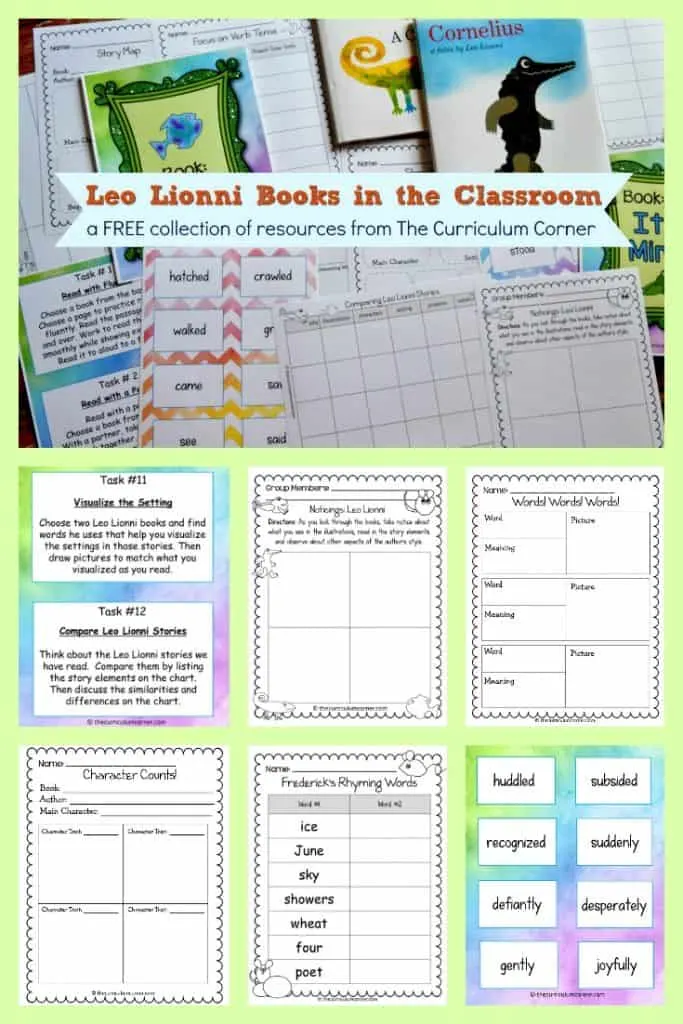
Cornelius
Past & Present Tense Verbs – We have compiled a list of verbs from the story. Show and discuss each word to your students and discuss whether they are past or present. Place them in a t-chart under the correct column. Students can also write them on their own t-chart pages.
Writing Prompt – Stories are a great for generating writing in your classroom. Students think about the characters they are reading about and then you can give them questions or scenarios to write about. For this story we have created three writing prompts you can use after reading the story. (We have also included a full page of writing lines you can copy onto the back for additional writing space.)
A Color of His Own
Story Elements Poster – We always found that our students loved story maps much better if they were supersized! If you have a poster maker, use our Story Map to create posters for students to complete in small groups. If not, you can simply copy the pages for individual students.
A Color of MY Own – Encourage your students to think about the story and figure out what color(s) they would want to be if they were the chameleon. This writing prompt has students making choices for their very own chameleon and then writing about why they chose those colors. (These would make a super cute bulletin board! Reading the reasons the students chose their colors would be so fun!)
You can download this complete Leo Lionni collection for reading here:
Lionni Activities
If you are looking for additional resources to accompany this Leo Lionni reading study: Using Leo Lionni as a Mentor Text
New to reading workshop? You might want to start here: Preparing Your Reading Workshop

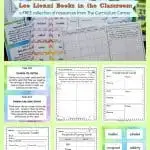
Suzanne Tecza
Thursday 28th of December 2017
Love them all!
Debbie Delaplain
Monday 3rd of April 2017
It's Mine was a favorite of my daughter when she was young! We read it A LOT!
Earlene McEwen
Friday 31st of March 2017
I have only read Swimmy and Color of His Own. They are both really great books.
Loran Davis
Wednesday 29th of March 2017
A color of his own is my favorite but I love them all! ?❤️
Kay Humbert
Wednesday 29th of March 2017
Swimmy!